Cover Story
A Journey to the Other Side
Elita Karim
Photos: zahedul i khan
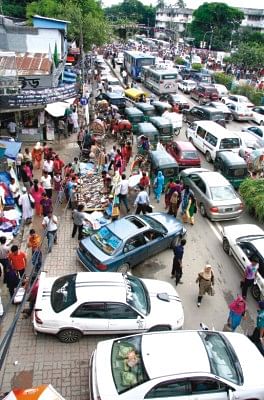 |
| A common scene in the capital: where vehicles, pedestrians and vendors collide. |
For a few years now, the authorities have been working on several projects to make commuting easier for the city dwellers, which would also solve the traffic problem in Dhaka. In the next two decades or so, the city will apparently have the metro rail, a few more fly-overs and maybe also an underground rail system, similar to the ones used in busy cities like New York and London. However, even though we do look forward to the plans and the projects to come to life, the cruel reality remains – the traffic jams have increased manifold in the last two years.
The traffic is causing a standstill on the road for hours together, it is paralysing day to day life. It is now almost impossible to even think of accomplishing more than two to three tasks in one day in the city, especially if the locations range from Old Dhaka, Purana Paltan, Gulshan and Uttara. In fact, today it would take more than two hours to move in a vehicle from Panthapath to Dhanmondi, and at least an hour and a half or more for one to drive from Gulshan 2 to Banani road 11. But our lives need to move on. What are the immediate steps that we can take to fight the traffic, move along with time and not get pushed far behind the rest of the world?
One of the quick and hassle-free methods that commuters, especially the young people prefer to use to get from one place to another in the city is walking or switching from one means of transport to another. Twenty-year-old Shariful Saadh Islam studies at a private university in Dhanmondi. He says that the best way to reach your destination on time is to switch your means of transport every time you are caught up in a never-ending traffic jam. “If I am on my way to Paltan from home, I would first take a rickshaw,” says Saadh. “In any case I would have to change to a bus after a while since it would take too long for a rickshaw to reach Paltan. If the bus I am on gets stuck on the road, I would simply get off and walk till I get on another bus which will take me to Paltan.”
Even though Saadh's innovative idea at tackling the traffic jam seems impractical and to a certain extent, slightly juvenile, many actually follow this method diligently. “This is the only way I can get to my destination on time,” says a 27-year-old aspiring photographer. “Avoid the highway or the main road, go for alternatives, and don't stay put in just one vehicle if your destination is too far away. Take multiples (means of transport)!”
The underpass located in Karwan Bazaar was probably something of a revolution when it was first built. Finally, people from Karwan Bazaar would be able to connect with the ones living in Panthapath without having to jaywalk across the main road or jump over wired-dividers. However, the underpass is equally dangerous for pedestrians and commuters. It has now become a temporary home for many of the homeless people living in the area. The underpass reeks of urine and has recently started a small shop selling shingaras and samosas. Even then, the underpass does serve the purpose of many who are desperate and have no other option but to use it. However, several times a day the underpass stays pitch dark for every other hour during load-shedding. Nevertheless, pedestrians use the underpass in the pitch dark, taking on the risk of getting mugged.

Traffic DC East, Awlad Hussain says that the government is doing all it can to reduce the traffic jams increasing by the day in the city. “However, the management is still not very strong,” he says. “The little things are being ignored, which are actually causing the main tension on the streets. For example, a large number of cars are parked right in front of offices, shopping centres and other commercial buildings. Either these buildings do not have underground parking spaces or the spaces are not too big to accommodate many vehicles. Everyone would like to park in front of their own offices, but if the parking is not managed properly, it leads to double parking and hence the roads become jammed up for pedestrians to move or for other vehicles to pass by.”
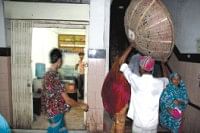 The Dhaka Metropolitan Police (DMP) has set up a few running tickers on the streets which warn drivers to drive slowly and to change lanes according to necessity and not carelessness. However, few drivers actually bother to spare a glance at the ticker messages. Swerving around, moving ahead in traffic and reaching their destination is their major concern on the street. “Not many drivers actually even know how to read properly,” says DC Hussain. “Once we have drivers, for both private and public transports, who are SSC or HSC certified, we can probably expect them to read the signs and messages on the streets.” Maybe if the DMP thought about slowing down the ticker messages and not running seven messages in one minute, drivers would be able to read the messages and eventually one day, understand them. The Dhaka Metropolitan Police (DMP) has set up a few running tickers on the streets which warn drivers to drive slowly and to change lanes according to necessity and not carelessness. However, few drivers actually bother to spare a glance at the ticker messages. Swerving around, moving ahead in traffic and reaching their destination is their major concern on the street. “Not many drivers actually even know how to read properly,” says DC Hussain. “Once we have drivers, for both private and public transports, who are SSC or HSC certified, we can probably expect them to read the signs and messages on the streets.” Maybe if the DMP thought about slowing down the ticker messages and not running seven messages in one minute, drivers would be able to read the messages and eventually one day, understand them.
The government has taken up a few more steps to tackle traffic jams especially in the month of Ramadan, like closing down schools for the month. Last week, to conserve electricity and also to ward off more traffic problems in the city, the government had issued an order to keep the gas pump stations to stay closed from 3 pm to 9 pm every day. However, what will happen after the month of Ramadan? Do we go back to square one? Thirty-year-old Raha Sabrin Sultana says that the government should increase the roads by 25 percent. Only then can we move around in peace. Sultana's idea might seem like a very easy solution, but it is obviously a very impractical if not impossible idea. “We have a large population living in the city,” says DC Awlad Hussain. “We don't have enough public transport to match the number of people. To top it all, our streets are small. But there is no way we can increase the size of the roads, at least not many of them. What we need now is more public transport, more buses on streets for people to use with ease on their way to work or anywhere for that matter.”
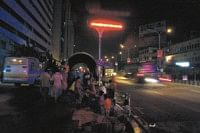 Frustrated and exhausted by hours-long traffic, the suffering city dwellers are bound to come up with innovative solutions. Many prefer to walk or switch vehicles to keep on moving. Some want the roads to be bigger while others say the smaller streets (not the main roads or the highways) should be fixed with pavements and lanes for walkers. One proposes the idea of quitting one's job to avoid commuting to the workplace every day and starting one's own business from his or her home! Frustrated and exhausted by hours-long traffic, the suffering city dwellers are bound to come up with innovative solutions. Many prefer to walk or switch vehicles to keep on moving. Some want the roads to be bigger while others say the smaller streets (not the main roads or the highways) should be fixed with pavements and lanes for walkers. One proposes the idea of quitting one's job to avoid commuting to the workplace every day and starting one's own business from his or her home!
However, what we have to come to terms with is that to develop the infrastructure in our country and also to move on in life, we the people need to come in contact with the outside world and communicate as much as possible. These streets are ours and there is now an immediate need to find out ways to ease the commuter's crisis. Notwithstanding the fact that the government has excellent proposals and long-term project plans for the country's transport system, which will eventually come to life in the next decade or so, we need some short term plans and ideas to solve the pedestrian's problems immediately.
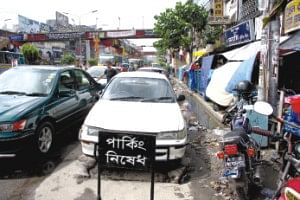 |
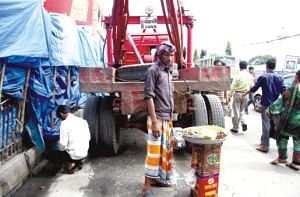 |
| Cars parked illegally, a very common sight in the city. |
The pavements and side-lanes for pedestrians are usually occupied with other activities. Some like to use them as a parking spots or makeshift shops while others prefer to use the corners of the lanes as a public toilet. |
Pavements, built for people to walk on, are broken or occupied. Because the pavements stay occupied most walkers have to find the smallest area to pass by, creating yet another human jam trying to move from one side to the other.
Over the decades, the increasing population in Bangladesh also include a large number of women who are now working professionally and spend a lot of time outside their homes. Many such women, in Dhaka, have to walk to places or use public transport. These women get touched and molested while trying to walk on the streets, pavements or the foot-over bridge.
In the first case, the foot-over bridge built on the pavement allows very little space for people to walk by. Hence, the woman in the photograph literally has to brush against the male pedestrian just to pass by. The line of people behind the man does not allow him to stop and wait for the woman to pass. Neither does he think of moving to his right, instead of his left, so that minimum body contact can be maintained between him and his fellow female pedestrian.
In the second case, a young man sits on the railing of the foot-over bridge, singing and whistling to his heart’scontent. He decides to take photos of a young women walking on the foot-over bridge on their way to work, or to class or maybe even home. Many call this eve-teasing. We call it sexual harassment on the streets.
A very common scene on the streets of Dhaka – pedestrians, cycle rickshaws, cars, buses and auto sall compete for the little bit of space on the street. While in some streets the pavements are broken and occupied, some streets don't even have pavements. The walking lanes on the sides are either filled with dirty water, unrecognisable creatures, filth and objects floating about or the public lanes are paved with ornamented gardens belonging to residential homes. Last week, a rickshaw, trying to move forward in the little space available on the small street with no existing side-lanes, fell over with passengers and all, when the wheels of the rickshaw got stuck in a puddle-filled pothole, a common sight in Dhaka's lanes.

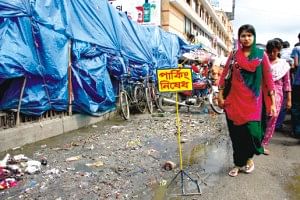 |
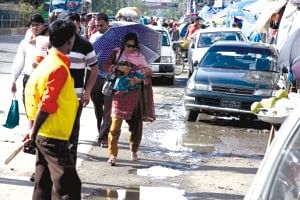 |
| The side-lanes are filled with filth, which forces pedestrians to use the roads meant for vehicles. |
Women are more likely to be sexually harassed on the streets. |
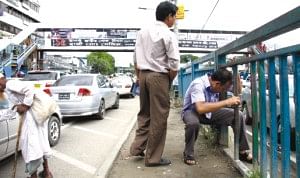 |
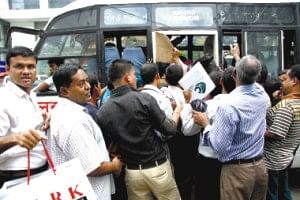 |
| Too scared to use the foot-over bridge, there are many who prefer to jay-walk to get to the other side. |
With the growing population in the city, more and more public transport are needed to ease the commuter's dilemma. |
opyright
(R) thedailystar.net 2010 |
| |
